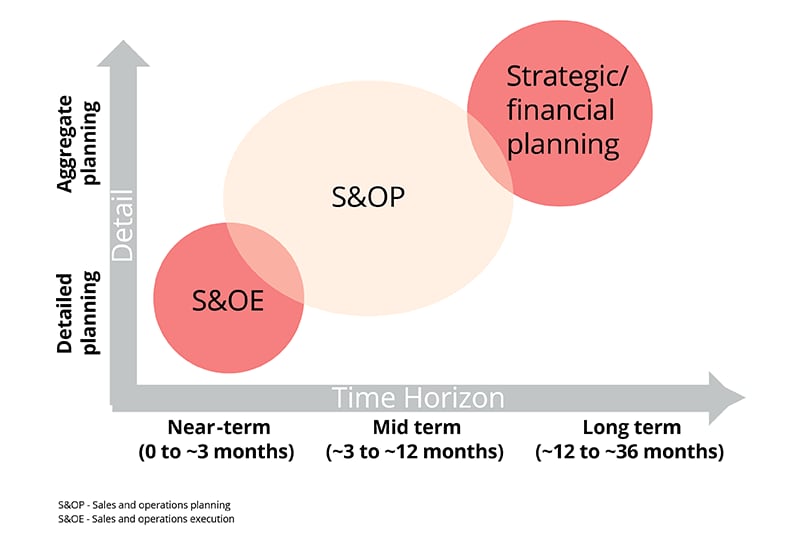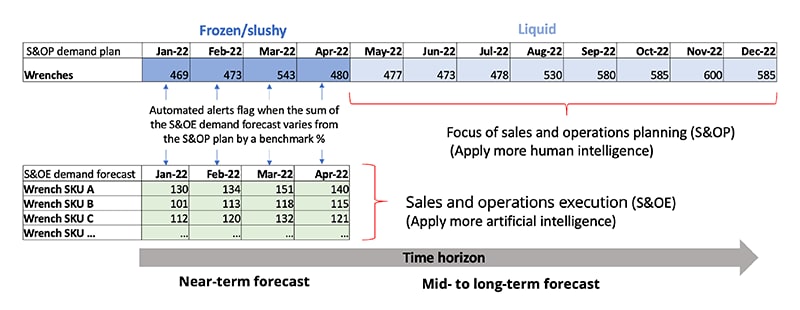The Human Touch in Sales and Operations Planning | Deloitte US has been saved
An automated supply chain world
In recent years, thought leaders have promoted greater automation of supply chain planning facilitated by artificial intelligence and machine learning (AI/ML). Articles on the subject are both insightful and well-intentioned, but they’ve had an unintended side effect: the erosion of functional (and still critical) sales and operations planning processes.
At the heart of the matter is an important question about the role of automation and AI/ML in supply chain planning. Where do they add value? Where should organizations slow things down to apply more human intelligence?
Supply chain sales and operations planning: A 20,000 foot view
To frame the discussion, it helps to think about planning along two dimensions—detail and time horizon (see figure 1):

Figure 1.
- Strategic/financial planning: The top right quadrant is the realm of strategic/financial planning. Led by executive leadership, planning here focuses on aggregate numbers such as total monthly revenue for the next 12 months, and is typically conducted alongside strategic discussions such as new market entry.
- Sales and operations execution (S&OE): The bottom left quadrant is often referred to as sales and operations execution (S&OE). Planning here focuses on the time horizon just beyond production lead-time, and involves final decisions about purchase/production quantities, logistics movements, etc., for hundreds to thousands of individual products.
- Sales and operations planning (S&OP): In the middle is the infamous S&OP process, which connects strategic/financial planning with operational execution (S&OE) through a monthly series of reviews. During S&OP, updated forecasts are compared to the strategic/financial plan. When shifts occur in the business landscape (supplier issues, competitor actions, etc.), S&OP serves as a checkpoint to realign the organization on the cross-functional response and potentially a new set of forecasts and targets for each function to collectively work towards. The focus of S&OP is on the mid to long-term horizon, and numbers are typically viewed at both the category and total level.
A great AI use case in supply chain
S&OE provides a great AI use case for three reasons: Decisions need to be made fast/frequently; they need to be made at scale (covering hundreds to thousands of products); and automated forecasts are generally more accurate over the near-term horizon (that is, the realm of S&OE).
- Speed: Imagine there is severe weather this week. A commonplace occurrence like this is unlikely to affect longer-range targets and strategic decisions. It could, however, ripple across inventory projections for the coming weeks or even months. If the ordering/production plan is not reset accordingly, dollars are left on the table. Because of this, high-functioning supply chains can help ensure S&OE decisions use market intelligence in near real time—and this is where AI can help with rapid ingestion of new data and output of updated plans.
- Volume: The advantage of AI when forecasting at high volumes is even clearer. Human intelligence is great for analyzing a single problem from many different angles—but facing 100 or 1000 products with similar problems, boredom, fatigue, and mistakes could quickly undermine performance.
- The near-term horizon: The time horizon of S&OE aligns with the capabilities of today’s advanced planning systems (APSs). While forecasting models have seen advancements in recent years, they are still a tremendous simplification of the real world. As time passes, the sales environment will likely change in ways most models don’t capture. Such changes include both external changes (economic, competitive, etc.) and internal changes, including strategic shifts such as launching new products, creating new alliances, entering new channels, etc.
The value of human intelligence in sales and operations planning
S&OP is, in many ways, the perfect Yin to the Yang of a more automated S&OE. S&OP improves mid- to long-range forecasts by leveraging human intelligence to capture novel external changes and align the company around internally driven strategic shifts. In addition, it can help mitigate certain risks of automation and complex models, including reduced forecast interpretability (perceived or real) and “garbage in, garbage out” automation caused by bad data.
- Improving mid to long-range forecasts: S&OP focuses on aggregate, category-level forecasts rather than the hundreds to thousands of product-level forecasts created during S&OE. This makes it a task humans can reasonably accomplish. More importantly, humans can not only do this task but have success at it because of the ability to factor in new information. Key drivers of mid- to long-range outcomes are the strategic actions that the company chooses to take. A well-functioning S&OP process helps companies align on those actions, making the forecast a self-fulfilling prophecy.
- Advancing cross-functional understanding of forecasts: What caused last month’s forecast variance? Why is the new forecast different? These conversations are central to a well-functioning S&OP process and help to address any reduced forecast interpretability (perceived or real) coming from the use of automation and more complex models.
- Keeping data clean and execution on track: In a well-functioning S&OP process, the resulting forecasts factor in new information provided by the cross-functional participants (product launches, new markets, alliances, etc.) and can help catch data when more automated S&OE forecasts do not. With familiarity, a benchmark variance can be established between the aggregate S&OE forecasts and the S&OP plan at the category level. Alerts can then be triggered if there is substantial divergence, contributing to a management-by-exception process (see figure 2).

Figure 2.
The path forward
State-of-the-art technology, including automation and AI/ML, can make planning more “real-time,” unlocking tremendous value in supply chain sales and operations. Companies would be remiss, however, to throw out slower, more manual planning practices. The traditional S&OP process, performed on a monthly basis with plenty of human input, remains critical as it helps companies align on structural changes and strategic shifts over the mid- to long-term horizon. Greater automation of S&OE may, in fact, make S&OP even more important, as a well-functioning S&OP can mitigate risks related to bad data and forecast interpretability. Companies can take the following three steps to get the best of both artificial and human intelligence in their planning processes:
- Implement new supply chain planning technology hand-in-hand with a review of the S&OP process to fully intertwine the human touchpoints.
- Ensure new tools/technology use the same product hierarchies and data as your S&OP process so all cross-functional participants can clearly assess the numbers and highlight areas for review.
- Establish a process where S&OE forecasts are summed to the category level and compared to S&OP forecasts. With familiarity, a benchmark variance can be established, and this process can itself be automated, triggering alerts when S&OE forecasts diverge from the S&OP plan.
Potential benefits in practice
In our experience, we’ve encountered organizations operating fast using new advanced planning systems (APS), but struggling to track how they arrived at current inventory levels and what working capital needs will be going forward. Did previous projections include the higher promo spend for August? When did they factor in the new prebuild strategy for home devices?
By revamping their S&OP, they were able to realign monthly on an aggregate working capital plan over the mid- to long-range horizon. When numbers began to diverge from the plan, they had greater clarity on the drivers and a clear process to respond. This not only drove better alignment in their supply chain strategy, but also in financial planning—with both marketing and finance included in the conversation.
Authors:
 |  |
| Vinay Rajani Managing Director Deloitte Consulting LLP vrajani@deloitte.com | Preeti AryaCrossman Managing Director Deloitte Consulting LLP parya@deloitte.com |
Thank you to our contributors: Michael Mccafferty and Jesse Miller.

